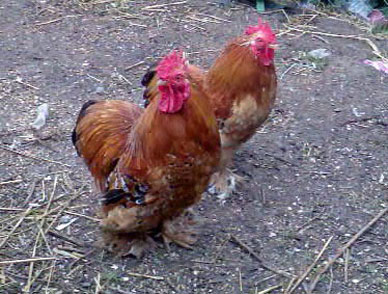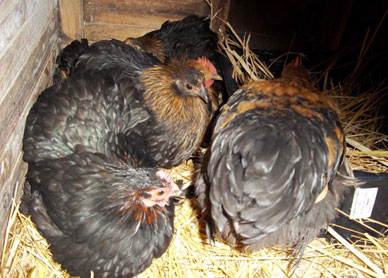Breed focus: A peek at Pekin bantams

Pekins are a true bantam breed, meaning that there is no large fowl counterpart.
As is often the case there are several suggestions as to the origin of the breed – the most popular alleges that they were stolen from the private collection of the Emperor of China in Peking in 1860 but it is also suggested that a consignment of birds from China around 1835 were given to Queen Victoria, assuming the name of ‘Shanghais’. These were bred with further imports and were developed into the breed we know today as Pekin Bantams.
They are often mistakenly thought to be Cochins which are purely a miniaturised version of a Standard Cochin which is the name Pekins are known as in Canada and the United States.

Pekin cockerels have long protruding foot feathers
Shorter than any other bantam, Pekins only reach 20-30cms in height and weigh approximately 570g for a hen and 680g for a cockerel. Their feet and legs are covered by their feathers. These are often called their trousers, or sometimes, skirts. Pekin cockerels have slightly longer feathers protruding outwards from their feet. Being very well feathered makes them look bigger than they actually are. They are often affectionately known as walking tea cosies, powder puffs or fluffy footballs!
Pekins are round bodied and walk with a slightly forward tilt, their heads a little closer to the ground than their beautifully intricate tails which look rather like a bustle. This tilt is one of the main characteristic of Pekins.
They are very docile birds and if handled gently when young they will happily let you pick them up and pet them – they will sit on your knee or perch on your shoulder. Cockerels can become aggressive and defensive of their hens, but they too are more amenable if handled regularly. Highly intelligent, they can be a little strong willed, but they can keep you entertained for hours with their antics. Real little comedians you will never be bored if you have Pekins.
Pekin hens go broody with great regularity and they make excellent mothers. Unusually the cockerels will often help with the nest building and may even take a turn in incubating eggs. It isn’t unheard of for cockerels to help mum with the upbringing of chicks and will even raise the brood themselves if mum is unwell or dies.
Moulting usually happens mid/late summer through to autumn and then they re-grow their feathers in winter. They lay small eggs which are normally cream in colour but can be various shades from light to a darker cream. Laying is not their strongest point but they do tend to lay in a pattern e.g. two days of eggs, and one day with no eggs.
They are a good breed to buy for a first time chicken keeper. They make excellent pets for children as they are naturally tame, settle very well and require less space than some bigger breeds. They also make good show birds especially for the novice.
Pekins can look rather pale and anaemic if not allowed on grass to forage but are normally a robust and long-lived bird that loves company. One of their best qualities however is that, although they love to forage, and have been known to help themselves to a little bit of what they fancy, they will not cause the same carnage to your veggie patch or your borders as some other breeds.

Some of the many colour variations of Pekin bantam
They are available in a whole range of colours. Lavender, blue, silver partridge, red partridge, blue mottled, columbian, cuckoo, mottled, buff, black, white, wheaten, millefleur and blue millefleur. There is also a frizzle variety who’s unusual curling plumage, rather than being smooth, looks rather like they have had an electric shock.
The only real drawbacks with this breed is that because of their feathered feet and legs they tend to collect insects and the like in them and bad weather conditions can cause dirt and mud to clump on their feet feathers. More often than not these clumps are easily removed if allowed to dry out because all that’s needed is to crumble the clumps with your fingers and it just falls away. Regular inspection of their legs and feet is required to search for mites and the like, although they will often eat them when preening themselves. They also preen one another, saving the owner the problem of finding their tiny bodies through all those feathers but, that said, it does not mean that the usual precautions against lice and mites should be ignored. Just like all chicken houses their bedding should always be kept clean and regular precautions should be taken to ensure their accommodation is also clean and as free of bugs as it can possibly be.
Related articles: Round up of true bantam breeds
14 Comments
Leave a reply
Poultry categories
Most recent Poultry articles
- Preventing egg laying problems in older hens with implants 15th March, 2017
- Integrating new chickens into an existing flock 15th May, 2016
- The nests in my heart – a personal view of ex-battery hens 22nd March, 2016
- Chicken FAQ: your most common chicken keeping questions answered 19th January, 2016
- Hens and herbs – no this is not a chicken recipe 08th October, 2015
- Feeding chickens: a balanced diet for backyard hens 16th April, 2015








My Blue Boy looks wonderful, Eirlys .Love Lindsay x
I was given four little bantoms inc a cockerel and found a picture on this site which looked like one of the peking ones so I now know what ive got, which has been helpful as I needed to know why the little fella seemed to have a sore foot and now I know to check them more than our clean, no featherd footed ones.i will now check more often for bits and bobs getting stuck in their featherd feet. thank you very much.
Glad you found the article helpful. Pekins are a wonderful, friendly, breed and I hope you enjoy you four new bantoms.
Nicely written article on my favourite breed such a shame some of the pictures of poor quality birds do not match the written description in the article.
Glad you enjoyed the article Anne. Many of the birds featured are pet bird and not necessarily show quality. If you – or other readers – have more pictures of this popular breed we would love to see them.
Does not state clear information about any minus they may also have like proned to any other diseases and what a good healthy bird should weigh
Generally Pekins are only prone to the same problems that might affect other breeds. As they have feathered feet they may get dirty and clogged with mud and the feathers may also hide foot problems like scaley leg mite so you should check them regularly. According to the standard males should be up to 680g and a female 570g. Hope this helps.
Other fault takes to long to answer people questions
Hi, I hope you find the answer helpful. Just to clarify this is not a forum as such so it can take a little longer for questions to be answered sometimes. If you have a question that is urgent I am happy for you to email me at the contact address.
Afraid i have to disagree with you there. A Pekin dosent have to be of show quality to resemble the written description. There are far to many feather legged cross breeds being passed off as Pekins as is healthy for the breed in general. Its gives people a false impression to what the breed should look like and perpetuates the problem.
It is true that some of the pictures in this article aren’t fantastic. I don’t always have exactly what I need in my archive so have to rely on images supplied but as far as I am aware all birds shown are pure Pekins. If you have pictures of birds that are closer, clearer or define the standard more closely I would be more than happy to publish them with credit to the photographer.
I’ve had two pekin bantams for 8yrs. Sadly one passed away today. I’m just wondering if this can emotionally effect the other?
They’ve both been excellent pets for my 3 children and they are very upset tonight
We do have other hens so the pekin isn’t alone
Like any animals chickens can form close knit bonds so it is possible that the ones left behind could be a bit emotional for a while. As long as they are not alone though they will perk up in a few days.
Two weeks ago i acquired four, nine month old hens, a Columbian pekin, two new Hampshire reds and a cuckoo waran.
I’m worried because they seem to have worked out the pecking order and settled in nicely, but the Pekin is constantly pecking at the others, and in checking them over, I’ve noticed bald patches on the other three, but no feathers lying around. Is she pecking them and eating their feathers? What can i do to stop her picking on the other three?